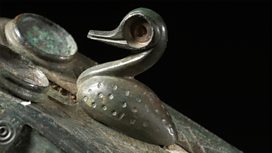Chinese Zhou Ritual Vessel
The history of the world through objects at the British Museum. Today, 3000 year old Chinese ritual and a bronze burial object
Neil MacGregor's history of humanity told through one hundred objects from the British Museum. Three thousand years ago, the world was in huge flux, with new powers creating sophisticated new societies - from the Middle East to South America - as older ones collapsed. In today's programme, Neil MacGregor finds out what was happening in China of that period and describes how a group of outsiders, the Zhou, overthrew the long established Shang dynasty. The story is told through a bronze bowl that was used for feasting. What does this beautiful bronze bowl tell us about the Zhou and life in China at this time? Dame Jessica Rawson and the Chinese scholar Wang Tao help paint the picture
Last on
![]()
Discover more programmes from A History of the World in 100 Objects about food and farming
About this object
Location: Possibly Henan Province, China
Culture: Ancient and Imperial China
Period: About 1100-1000 BC
Material: Metal
Μύ
This ritual vessel was used for offering food to ancestors. This example is decorated with large tusked animal heads swallowing birds. Sacrifices to ancestors ensured the survival and success of those who performed them. Respect for ancestors has been a central part of Chinese life for thousands of years. This vessel was made through sophisticated bronze working techniques that were not employed in the Middle East or Europe until much later.
What is the legacy of the Zhou dynasty in China?
An inscription inside the vessel describes an attack by the Zhou king on the dynasty they overthrew - the Shang. Many of China's significant institutions were established during the Zhou period. Most important is the mandate of heaven - the notion that heaven blesses the authority of a just ruler. An incompetent ruler could be displaced by the people with the favour of the gods. This would become a central aspect of Chinese politics.
Did you know?
- The Chinese Zhou dynasty often referred to its predecessor, the Shang, as alcoholics.
Chinese bronze vessels
By Professor Dame Jessica Rawson, Warden of Merton College, Oxford
Μύ
These bronzes that we call ritual vessels were used for a long time - from around 1300 BC down to at least 300 BC. All ritual vessels were made to give food and wine to the dead.
The first dynasties of China, the Shang and the Zhou, made large numbers of fine bronze containers for food, for alcohol, for water, and used these in a big ceremony, sometimes once a week, maybe once every 10 days. The belief is that if food, wine or alcohol is properly prepared, it will be received by the dead and nourish them and those dead, the ancestors, will look after their descendants in return for this nourishment.
The bronze vessels which we see today were almost all buried in tombs or in hoards. They were prized possessions for use in life. They were not made primarily for burial, but when a major figure of the elite died, it was believed that he would carry on offering ceremonies of food and wine to his ancestors in the afterlife, indeed, entertain them at banquets. They were also buried in large hoards when the state faced great danger. A member of the royal family might own up to 200.
The most famous bronze vessels are those dating from the early Shang dynasty down to the early Zhou dynasty – 300 or 400 years. These are made in very exquisite shapes, often rather spiky, with very fine decoration that we today can hardly replicate. They are all cast, that is, they are made by using mould sections and pouring hot metal into them and then removing the clay moulds. And it is astonishing how detailed the decoration is.
Sometime around 850 BC, the Zhou dynasty which was then in power, came into some considerable difficulty, political, perhaps dynastic. And all of a sudden, we see in the bronzes that they make, that some big religious change has taken place. Gone are the very fine spiky shapes with the detailed decoration, instead the bronzes are much larger. They have very smooth outlines and wave patterns, or rather, abstract patterns on them which are not at all as delicate as the earlier ones.
We have more repetitive food vessels, and many fewer vessels for alcohol. That means the choreography has changed. So when change of this sort in ritual has taken place, we have to infer that some rule, some decision was made at the court of the Zhou dynasty to make this change, and then they ordered a completely new set of vessels to be used all over the very large state that they ruled.
Transcript
Broadcasts
- Wed 17 Feb 2010 09:45Βι¶ΉΤΌΕΔ Radio 4 FM
- Wed 17 Feb 2010 19:45Βι¶ΉΤΌΕΔ Radio 4
- Thu 18 Feb 2010 00:30Βι¶ΉΤΌΕΔ Radio 4
- Wed 19 Aug 2020 13:45Βι¶ΉΤΌΕΔ Radio 4
Featured in...
![]()
Food and Farming—A History of the World in 100 Objects
A History of the World in 100 objects - Food and farming
Podcast
-
![]()
A History of the World in 100 Objects
Director of the British Museum, Neil MacGregor, retells humanity's history through objects





